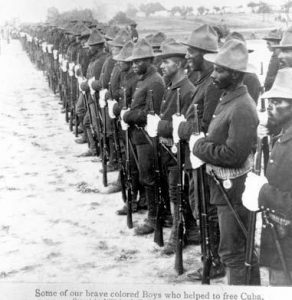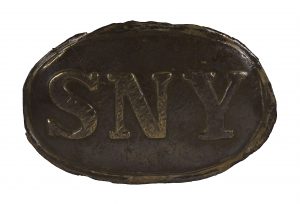Written By: Matthew J. Seelinger

During the 1950s and the height of the Cold War, U.S. defense policy, under the administration of President Dwight D. Eisenhower, centered on an increased reliance on nuclear weapons.
This policy, often referred to as the “New Look,” called for an economized force structure that relied more on nuclear weapons delivered by long-range bombers and missiles, rather than conventionally armed forces.
As a result of the New Look and the concept of “massive retaliation,” the role of the Army in future conflicts was unclear.
In order to maintain its relevance to the nation’s defense in the age of nuclear warfare, the Army re-organized its ground forces for deployment on the nuclear battlefield, resulting in the development of the Pentomic division and tactical nuclear weapons in the form nuclear artillery rounds.
The Army also developed and deployed a series of rockets and missiles during the 1950s capable of carrying nuclear warheads, including the Corporal, Redstone, Honest John, and Lacrosse. On 7 January 1958, upon a recommendation from the Joint Chiefs of Staff, Secretary of Defense Neil McElroy authorized the Army to proceed with development of a mobile, solid propellant missile to replace the Redstone ballistic missile.

The Redstone was a powerful and reliable system, but it was a large missile (just over sixty-nine feet in length) and had limited mobility. Furthermore, it was liquid-fueled and took considerable time to prepare for launch.
The new missile, originally called the Redstone–S (S for solid), was to use much safer solid propellant that allowed the missile to be launched on short notice.
On 16 January, the Department of Defense announced that the Redstone-S would be named the Pershing, after General of the Armies John J. Pershing, commander of the American Expeditionary Forces in World War I and Army Chief of Staff from 1921 to 1923. The Army’s specifications for the Pershing were stringent. For maximum mobility, the Pershing was to weigh no more than 10,000 pounds and include two stages.
The missile was to have a minimum range of 100 nautical miles and a maximum range of 300 nautical miles. A mobile transporter-erector-launcher (TEL) would transport the Pershing to its launch site, erect it, and fire it within minutes, before quickly moving to another launch site (“shoot and scoot”). The missile’s transport and support equipment would be contained in four lightweight, fully tracked vehicles.
On 28 March 1958, the Army awarded a contract to the Martin Company (later Martin Marietta) for research, development, and initial production of the Pershing system.
In just over a year, Martin delivered the first Pershing to the Army. On 25 February 1960, the Army conducted the first test launch of a Pershing at Cape Canaveral, Florida. In October 1961, Martin Marietta was awarded a production contract for Pershing missiles and ground support equipment. In June 1962, the 2d Missile Battalion, 44th Artillery, became the first unit to be activated specifically for the Pershing.
The 2-44 Artillery, which was assigned to Fort Sill, Oklahoma, the home of the Army’s Field Artillery Center, would serve as the training unit for the Pershing. The original Pershing battalion was comprised of a headquarters and headquarters battery, a service battery, and four firing batteries, with each firing battery equipped with one launcher. Over the years, the organization and number of Pershing units would undergo several changes. The Army originally planned for ten Pershing battalions, but this number was soon reduced to five; in 1968, that number was dropped to four. The first operational Pershing missiles delivered to the Army beginning in December 1962 stood just over 34 feet tall, had a diameter of 3.3 feet, and weighed 10,263 pounds.
The missile consisted of two stages, both manufactured by Thiokol; the first stage’s rocket motor produced 25,900 pounds of thrust, the second 19,100 pounds of thrust. The two stages pushed the Pershing’s range to 400 miles at speeds approaching Mach 8. The Pershing’s ST-120 inertial guidance system, built by Eclipse-Pioneer, gave the Pershing’s W50 nuclear warhead, which had a selectable yield of 60, 200, or 400 kilotons, an accuracy of 400 meters circular error probable (CEP). The Pershing’s fully tracked TEL was designated as the M474. Three other vehicles provided support equipment for the missile and TEL. In contrast, the Redstone required as many as twenty support vehicles. The first Pershing battalion to be deployed to Europe, 4th Missile Battalion, 41st Artillery, became operational in June 1964 at Hardt Kaserne in West Germany.
The 4-41 Artillery was eventually joined in West Germany by two additional battalions. The 1st Battalion, 81st Artillery, was assigned to McCully Barracks near Mainz in October 1964. The 3d Battalion, 84th Artillery, arrived in West Germany in May 1965 and was posted at Artillery Kaserne, Neckarsulm. Later, on 17 January 1986, all three Pershing battalions were redesignated as battalions of the 9th Field Artillery—4-41 Artillery became the 2d Battalion, 9th Field Artillery; 1-81 Artillery became the 1st Battalion, 9th Field Artillery; and the 3-84 Artillery became the 4th Battalion, 9th Field Artillery. The three battalions came under the command of the 56th Artillery Group, later designated as the 56th Artillery Brigade in 1970, which was later replaced by the 56th Field Artillery Command on 17 January 1986. The 2d Battalion, 4th Infantry, was eventually added to the 56th to provide area security.
Because of the nature of the Pershing missile system, officer positions in Pershing units were increased by one grade: platoons were commanded by captains, not lieutenants; batteries were commanded by majors instead of captains; battalions were commanded by colonels instead of lieutenant colonels; and the 56th Artillery Group/Brigade/Command was commanded by a brigadier general rather than a colonel. West Germany became the only other nation to acquire Pershings for its armed forces.
Two wings of the West German Luftwaffe were equipped with Pershings. The missile’s nuclear warheads, however, remained under the control of the U.S. Army. The original mission of the Pershing was to provide tactical nuclear support to Seventh Army.

In 1965, however, the Supreme Allied Commander Europe (SACEUR) assumed control of the Army’s Pershings as theater-wide weapons to augment NATO’s strike-force capability.
The Pershing was also given the quick-reaction-alert (QRA) mission for SACEUR, which called for two firing batteries in each Pershing battalion to be on alert at prepared firing sites; a third would be on alert at the battalion’s home station; and the fourth on maintenance status.
To increase quick-reaction capability and firepower, each battery was authorized two additional launchers; in 1966, this number was increased to eight.
The new missions required revamped support equipment, including a switch from tracked to wheeled transport vehicles. The wheeled vehicles proved faster and more reliable than the earlier tracked transports, and their softer ride created less wear and tear on the missile.
Other changes and improvements included a sequential launch adapter which allowed three missiles to be launched in quick succession. Another improvement was the addition of an automatic reference system that eliminated the need for pre-surveyed firing sites and allowed “on-the-spot” launches. No modifications were made to the actual missile, 754 of which were produced. This new system, designated the Pershing Ia, was fielded between 1969 and 1970 under Project SWAP, during which new systems replaced old ones. (The older Pershing systems were designated Pershing I).
The biggest change was to the number of launchers per battalion. With the fielding of the Pershing Ia, each battalion now had thirty-six launchers, up from eight. As a result, new Tables of Organization and Equipment (TO&E) authorized a strength of 1,680 officers and enlisted men per Pershing battalion, although this was later reduced to 1,300.
In 1973, the Army formed a task force to study a follow-on system to replace the Pershing Ia that called for greater accuracy and a smaller warhead. The following year, the Department of Defense authorized the Army to proceed with advanced development of what would become the Pershing II missile. In March 1975, the Army awarded the Pershing II contract to Martin Marietta, and on 18 November 1977, the first Pershing II test firing took place at White Sands Missile Range, New Mexico. In 1978, in response to the Soviet Union’s deployment of the SS-20 (NATO code name Saber) mobile medium-range missile in Eastern Europe in 1976, NATO formally requested deployment of the Pershing II to Western Europe. NATO officials formally approved the Pershing II basing in December 1979.
On 18 February 1980, President Jimmy Carter granted the Pershing II the highest priority for the development of a weapon system. By December 1981, the Pershing II entered the production phase. In all, approximately 380 Pershing IIs were manufactured. Since the Strategic Arms Limitation Treaty II (SALT II) agreements stipulated that no new launchers could be built, the Pershing II had to fit onto upgraded Pershing Ia launchers (designated M1003). The new missile itself, however, was significantly different in several ways. While it was only slightly longer (34.8 feet versus 34.4) and had the same diameter (3.3 feet), the Pershing II was about 6,000 pounds heavier than earlier Pershings.
Nevertheless, more powerful rocket motors, developed by Hercules, stretched the Pershing II’s range to approximately 1,200 miles, as opposed to the Pershing Ia’s range of 400 miles. The improved range allowed NATO to strike targets in the western Soviet Union. The Pershing II also featured a new and more accurate reentry vehicle (RV) that included an active radar guidance system developed by Goodyear Aerospace. Upon reentry, terrain-mapping radar in the nose scanned the area below, comparing the resulting radar image with the map stored in the missile’s guidance computer.
Small fins at the base of the RV adjusted the trajectory until the radar and computer maps matched. This gave the Pershing II an accuracy of 100 feet CEP. As a result of improved accuracy, the Pershing II carried a much smaller warhead, the W85, which had a selectable yield of five to fifty kilotons. Another warhead originally intended for the Pershing II, the W86 ground penetrator warhead, was later cancelled. The first Pershing IIs arrived in Europe on 22 November 1983, hours after the West German Bundestag voted to deploy the missile in the Federal Republic of Germany.
By 15 December, Battery A, 1-41 Field Artillery, was certified as the first combat ready Pershing II battalion. All three Pershing II battalions reached full operational capability on 13 December 1985. The only fatal incident involving the Pershing occurred on 11 January 1985, when three soldiers from the 3-84 Field Artillery were killed while conducting routine assembly operations on a Pershing II missile stage. The three soldiers perished when a discharge of static electricity ignited the motor as they removed it from its shipping container. The service life of the Pershing II turned out to be relatively short. On 8 December 1987, President Ronald Reagan and Soviet General Secretary Mikhail Gorbachev signed the Intermediate-Range Nuclear Forces (INF) Treaty in Washington, DC.

The provisions of the treaty called for the elimination of all ground-launched nuclear ballistic and cruise missiles with ranges between 300 and 3,400 miles. Among the weapons to be eliminated by the treaty were the Pershing II and the Soviet SS-20.
The Senate ratified the INF Treaty on 27 May 1988; it went into affect five days later. One provision of the treaty called for American and Soviet inspectors to be on hand to watch the destruction of each side’s weapons.
On 1 September 1988, the first Pershing II battery stood down. A week later, the Army began eliminating Pershing rocket motors at the Longhorn Army Ammunition Plant in Texas. The motors were static fired, then crushed in a hydraulic press. Motors and other sections of the Pershing, including RVs, airframes, and other equipment were also destroyed at the Army’s Pueblo Depot Activity in Colorado. The Pershing IIs’ W85 warheads were removed, modified, and reused as B61 gravity bombs.
On 1 October 1990, the last Pershing II was shipped back to the United States for destruction. In May 1991, the last Pershing II rocket motors were destroyed in accordance with the INF Treaty, which called for the elimination of all INF systems by 31 May 1991. The INF Treaty allowed each side to retain as many as fifteen inert missiles for display purposes. On 18 June 1990, a dedication ceremony was held at the Smithsonian’s National Air and Space Museum in Washington, DC, for an INF Treaty exhibit that featured a Pershing II and a SS-20. The Central Armed Forces Museum (formerly the Soviet Military Museum) in Moscow features a similar exhibit. A Pershing I and Pershing II are on display at the Army’s White Sands Missile Range Museum. Several pieces of Pershing IIs and SS-20s also formed part of an art exhibit at the United Nations headquarters in New York City.
The U.S. Army’s Pershing missile served as a key part of America’s nuclear deterrent for over twenty-five years and established a proud new legacy for the Army’s Field Artillery branch. Fortunately, no Pershing was ever used in combat, and thus it helped to prevent a war that would have been unprecedented in the annals of history.


